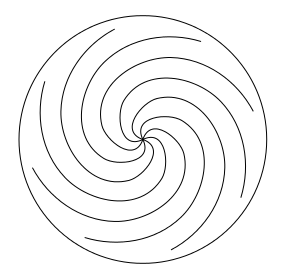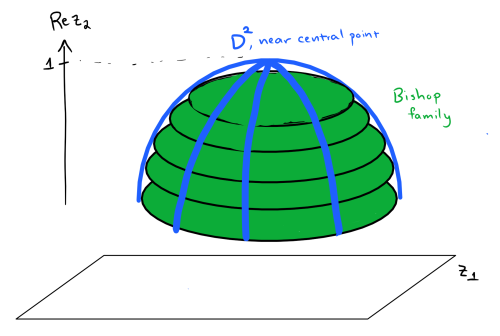This is a continuation post following part 1. Hope the delay wasn’t too long – more coming soon.
A preparatory comment on last time
Let us quickly recall the proof sketched in part 1 that fillable implies tight for contact . The idea was that if we had a filling
, then the presence of an overtwisted disk locally gave a Bishop family of holomorphic disks as part of a 1-dimensional moduli space, but the compactified moduli space was seen to have only one boundary point. This was because continuing the family away from the center of the overtwisted disk could not lead to a possible boundary point – in our version, such a point would require a bubble, but we considered exact fillings.
It was mentioned last time that Eliashberg’s paper on fillings by holomorphic disks actually covers the weak case instead. The difference is that one now instead shows that any closed surface in a contact boundary which is weakly filled indeed bounds a 3-manifold which can be foliated by holomorphic disks. With this result, we never actually need to consider bubbles on the interior, so we can remove the exactness assumption.
I want to point this out because although this isn’t perfectly analagous to the discussion in the next section on Wendl’s paper, it is related in basic idea. The set-up is different, sure, and also one cannot work directly with the contact manifold with its filling (the necessity of a strong filling appears in the need to attach a positive cylindrical end), and finally also the completed foliation does have (isolated) nodal curves, but in the end we end up with a nice Lefschetz fibration with holomorphic fibers, and that’s pretty powerful, just like Eliashberg’s disk fillings. We explain this… now!
On Wendl’s Strongly fillable contact manifolds and J-holomorphic foliations
I should say, first of all, that one can generalize the results I am discussing here. For a somewhat more general discussion, see this post by Laura Starkston from 2013.
In this section, all contact manifolds are 3-dimensional and all symplectic manifolds are 4-dimensional.
We begin by recalling that the symplectization of a cooriented contact manifold is the symplectic manifold
, where
is the
-coordinate. This symplectic manifold does not depend upon the choice of
, since if we chose
, then
where
is the diffeomorphism of
sending
.
Remark: One can define this in a more invariant way. The symplectization of is the set of covectors vanishing on
. This is an
-bundle over
and is symplectic with respect to the standard symplectic form on
. Fixing a local section
over
gives a coordinate
for the fiber such that the symplectic form is just
. We simply take the component where
and
coorients
.
Given a symplectization, explicitly determined by a chosen contact form , one typically studies J-holomorphic curves only for choices of
which are admissible, meaning:
is
-invariant
is a compatible almost complex structure for
Under these conditions, finite energy J-holomorphic curves from punctured Riemann surfaces are analytically easy to understand – the punctures are asymptotic to Reeb orbits at the positive and negative ends, and Gromov compactness extends to this setting in that one needs to include holomorphic buildings. One can imagine, for example a sequence of -holomorphic curves which look like some union of cylinders over Reeb orbits for all but a union of two intervals
on which there is nontrivial behavior, where
remains fixed but
. In the limit, as these two intervals get farther apart, we break into two holomorphic curves in the symplectization. This forms what is sometimes called a holomorphic building. In general, there may be multiple levels in the limit, as in the figure below.
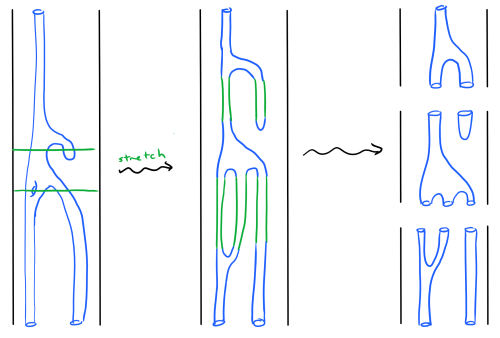
Here, a J-holomorphic curve gets stretched out in two places, shown in green, until eventually these green almost cylindrical parts get infinitely long. In the limit, we obtain a three story holomorphic building.
For more details in much more generality, one should consult this paper of Bourgeois, Eliashberg, Hofer, Wysocki, and Zehnder.
Now suppose that we have a strong filling of a contact manifold
. Then by definition, we have a Liouville vector field
whose flow allows me to identify a neighborhood of
with a subset of the symplectization of the form
where
is a contact form for
on
. One can append the rest of the positive end of the symplectization,
, to form a completed symplectic manifold
. I can choose some compatible almost complex structure
which far enough into the positive end is a restriction of some admissible
. In this case, one can study J-holomorphic curves, and we have a similar Gromov compactness statement. In this case, our curves can either bubble, or form holomorphic buildings where the lowest level is just
and whose higher levels are all
.
Theorem (vaguely stated): Under some technical analytical conditions, an -invariant foliation of
by
-holomorphic curves of uniformly bounded energy will extend, with isolated nodal singularities, to the interior of
(and hence to all of
).
Proof (sketch): We study the compactification of the moduli space of finite energy J-holomorphic curves in
, and in particular, the closure of the component
of the moduli space containing a special leaf in the symplectization end. This component is 2-dimensional, and hence is precisely given by the foliating leaves around it (recall
is 4-dimensional). The closure of this component yields the full J-holomorphic foliation, where some isolated finite subset of the leaves are actually nodal curves.
In the end, by considering on which curve in the foliation a point is located, this yields a map , where the fibers are symplectic (since they are J-holomorphic and
is compatible with
) and generically smooth except with finitely many nodal singular fibers, forming what is called a symplectic Lefschetz fibration.
We will discuss this notion more in a future post, where we will also see that Stein fillings correspond in some sense to certain (“allowable”) symplectic Lefschetz fibrations over a disk. Hence, one can ask – are there some examples of contact manfiolds on which we can find a finite energy foliation on the symplectization
satisfying the correct analytical assumptions and such that
? The answer is yes in the case when
is supported by a so-called planar open book, as was proved in this paper by Wendl. We will define this in a future post, but this discussion implies (up to how to tackle the word “allowable”) that:
Corollary: For contact 3-manifolds supported by a planar open book, strong and Stein fillability are equivalent.
Along similar lines, one can find finite energy foliations for the standard 3-torus (with contact structure induced by the restriction of the Liouville form on
to the unit cotangent bundle). In this case, any strong filling, not just the standard one, would have
, and so any strong filling of
arises as the boundary of a Lefschetz fibration to
. Wendl then beefs this up to prove, for example, that every minimal strong filling of
is diffeomorphic to
.
Finally, one can use these results to obstruct strong fillability in a manner analogous to the Bishop family argument. That is, if has a finite energy foliation satisfying the technical analytic assumptions, then one should be able to extend that foliation to a strong filling. Recall that the foliation extended by considering the component of the moduli space containing some specified leaf
satisfying some conditions. If there is some other leaf
which is not diffeomorphic to
, then they cannot both be fibers of the same Lefschetz fibration, and so there couldn’t have been a strong filling in the first place. There are also other more technical versions of this argument, which for example allow one to reprove that positive Giroux torsion, i.e. that there is a contact embedding of
, obstructs fillability, originally proved by David Gay using gauge-theoretic methods which are completely avoided in this approach.
On Barth-Geiges-Zehmisch’ The diffeomorphism type of fillings
As we have now seen twice, the technique of comparing moduli spaces of J-holomorphic curves to the topology of the situation in question is very powerful. We saw this both in our discussion last time of McDuff’s rational ruled classification, and we also just saw in our discussion of Wendl’s paper that the breaking which occurs in the compactification of a certain moduli space of curves in a strong filling of the positive end of a symplectization actually cooks up a Lefschetz fibration. One can view this paper as another instance of this way of thinking – here evaluation maps end up directly producing strong restrictions on the topology of a filling.
As we will see in a future post, Weinstein fillings of contact manifolds have a surgery theory consisting of handles of index at most
, and so they have the homotopy type of a CW complex of at most this dimension. A subcritical Weinstein filling is then one where all the handles have index at most
. The main theorem states that the existence of just one subcritical Weinstein filling places restrictions on the topology of any strong symplectically aspherical filling
. By symplectically aspherical, we mean that
.
Theorem [BGZ]: If is a contact manifold of dimension
admitting a subcritical Stein filling with the homotopy type of a CW complex of dimension
, then any strong symplectically aspherical filling
satisfies
for
via the isomorphism induced by inclusion
otherwise
- If
, then all strong aspherical fillings of
are diffeomorphic.
Corollary [Eliashberg-Floer-McDuff ’91]: Every symplectically aspherical filling of the standard contact sphere is diffeomorphic to a ball.
Remark: For , which is just the lens space
, McDuff’s theorem from last time about fillings of lens spaces implies that there is a unique minimal filling up to diffeomorphism. By positivity of intersection, symplectically aspherical fillings are minimal, which implies the above result. But also, since
is automatically a trivial cohomology class on the ball, McDuff’s result implies that the filling is in fact unique up to symplectomorphism. This result goes back to Gromov’s ’85 paper.
We won’t quite make it to a proof of the full theorem, but we will see some of the inner workings in the statement of the theorem stated below. We proceed by making an extra definition (not in Barth-Geiges-Zehmisch) to clarify the exposition.
Definition: Let be a connected contact manifold and
a Liouville manifold of finite type (meaning it is modelled after a positive symplectization outside of some compact region). Let
be the corresponding Liouville vector field (satisfying
). The
is called
–spliffable (yes, this is what we called it at Kylerec) if
is contactomorphic to a hypersurface
in
such that:
is convex, meaning it is transverse to the vector field
where
is the standard radial Liouville vector field on
- the infinite component of
is modelled after the positive symplectization of
meaning this component is the union of the positive flow of
along
Remark: A contact manifold which is fillable by a subcritical Weinstein manifold is spliffable. This follows from a result of Cieliebak that subcritical Stein manifolds are split.
Theorem: Let be an aspherical strong filling of a
-spliffable contact manifold
. Then there exists a commutative diagram of the form

(and similarly with replaced with
).
Remark: The Eliashberg-Floer-McDuff theorem is already a corollary of this weaker statement, using that is
-spliffable, and using smooth topology.
Corollary: The unit cotangent bundle of a closed manifold
admits no subcritical Weinstein fillings.
Proof: We need surjects onto
with
the standard unit disk filling and
is
-spliffable. But if
admits a subcritical filling, then
can be chosen to be subcritical so that
. This is a contradiction.
Proof of the main theorem:
We begin by embedding into
so that it is convex (which we can do by the spliffability condition). The interior component determine by the splitting through
can then be replaced by
by gluing in (since strong gluings are set up to be Liouville near the boundary). Call the interior of this manifold
. We can then choose a map
such that the interior embeds diffeomorphically onto
. This embedding then gives us a smooth manifold
which looks like
but with the interior component replaced by
. That is,
.
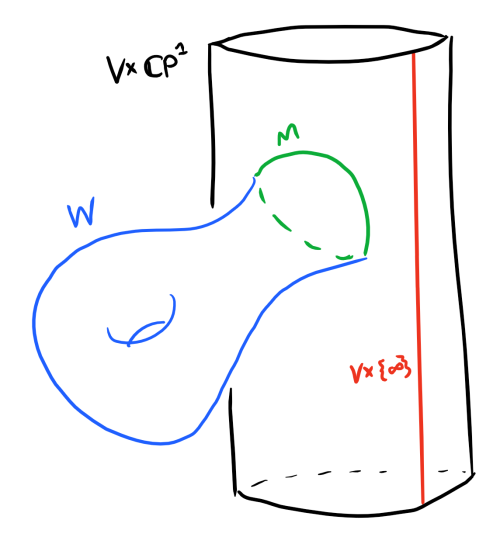
We then wish to study some -holomorphic curves on this manifold. We pick a compatible
which away from
is of the form
, where
is admissible (as discussed in the previous section) for
. We study the moduli space
of
-holomorphic spheres
such that
(for some
large enough so that this slice misses
). We really want this up to reparametrization, so we fix slice conditions to define this moduli space: that
,
, and
, for some choice of
distinct and not
.
The key about positive symplectization ends is that admissibility of the almost complex structure implies a maximum principle for these curves. This implies the following two items.
- Since
looks like a symplectization, in
, any curve in our moduli space must have actually just been
.
- Any curve in our moduli space intersecting
must intersect
. First of all,
is symplectically aspherical, so any holomorphic sphere must leave
. But then, if it didn’t intersect
, it would be contained completely in
, which contradicts this maximum principle.
Now, this moduli space is an oriented manifold of dimension , and it comes with an evaluation map of the form
. This map is actually proper and degree 1, which follows from the maximum principles just described, plus a little boost from positivity of intersection which implies that there is no need to worry about stable maps in the compactification of
. This then restricts to a proper degree 1 evaluation map
.
Hence, we obtain the following commutative diagram.

In homology, the right triangle becomes the desired triangle from the theorem.
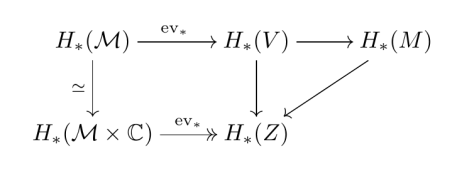
As for the surjectivity part of the theorem, note that the leftmost vertical arrow is an isomorphism. Meanwhile, the bottom horizontal arrow is surjective for standard topological reasons (because one can cook up an explicit shriek map which is right inverse to
on the level of homology).


